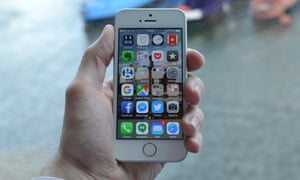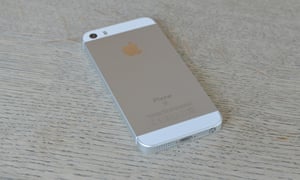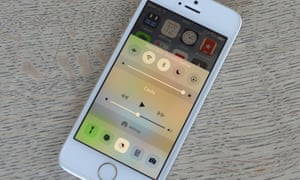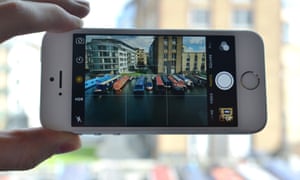Apple iPhone SE review – too small for most
Taking the guts of the iPhone 6S and squeezing them into the frame of
the iPhone 5S is great, but only those who really want a 4in phone
should buy one

The new iPhone SE comes in at the bottom end of Apple’s iPhone range on cost, below the iPhone 6S and 2014’s iPhone 6, a spot typically filled by last year’s model. It’s now the only smartphone Apple makes with a screen smaller than 4.7in, which for some could be a big deal. For others it could be a deal breaker.
iPhone 5, 5S or iPhone SE?

It’s still relatively slender at 7.6mm thick - its hard square edges make it feel thicker than it is - and it weighs 113g, which is quite light for a smartphone these days. Then again, it’s very small for a smartphone in 2016.
The screen is the same as the 5S, 4in on the diagonal with the same quality colours, brightness and blacks. Compared to the iPhone 6S the screen is noticeably weaker, with poorer blacks and vibrancy. It’s not a bad screen by any stretch of the imagination, it’s just a good screen from two years ago, which is exactly what it is.
In the hand the body feels sharp and hard, with unforgiving edges which are only acceptable because of the phone’s diminutive size. The hard edges are easier to grip than the slippery rounded sides of the iPhone 6S, and particularly the large 6S Plus, but they hurt my palms after clutching it for an hour or two.
The iPhone SE’s closest rival is the excellent Sony Xperia Z5 Compact, which has a significantly larger 4.6in display, weighs 138g, is 8.9mm thick and has slightly larger dimensions. Practically no other 4in devices in this high-end category exist anymore.
Using a 4in screen in 2016 is a compromise. Websites feel very cramped, apps often leave only a small amount of screen to the content they’re trying to display and buttons can end up very small making tapping them a bit of a challenge.

Specifications
- Screen: 4in 1136 x 640 pixels (326 ppi)
- Processor: dual-core Apple A9
- RAM: 2GB of RAM Storage: 16/64GB; no SD card
- Operating system: iOS 9.3
- Camera: 12MP rear camera, 1.2MP front-facing camera
- Connectivity: LTE, Wi-Fi, NFC, Bluetooth 4.2 and GPS
- Dimensions: 123.8 x 58.6 x 7.6mm Weight: 113g
Three generations in one device
Performance is much faster overall than the iPhone 5S and feels similar to that of the iPhone 6S, apart from the fingerprint sensor, which is pretty slow for a 2016 smartphone costing £350+. It’s the same original Touch ID sensor from the iPhone 5S/6, not the new, much faster Touch ID sensor from the 6S, which is disappointing.
The iPhone SE’s battery life is better than the 6S, mirroring that of the 6S Plus. Using it as my main device, with hundreds of emails, push notifications, three hours of browsing and listening to music - without the Facebook app installed - the iPhone SE lasted a solid working day. I went to bed with 10% battery left and work up eight hours later with 5%.
Compared to other iPhones, most will see better battery out of the SE, but it doesn’t come close to its closest Android competitor, the Xperia Z5 Compact, which lasted as long as three days between charges.
Call quality was excellent. I also didn’t suffer from the reported Bluetooth audio issues.
iOS 9

It includes features such as Apple’s Night Mode, which reduces the amount of blue light emitted by the display in the evening to help you sleep. It’s the exact same version running on the iPhone 6S currently and behaves as such, minus the 3D Touch gestures that the SE does not support.
It’s worth noting that iOS works better on smaller devices, where your thumb can reach all areas of the screen. Activating the Control Center feels more consistent, as does swapping between apps using the task switcher on the smaller screen.
Camera

It is a big step up from the iPhone 5S with 4K video recording and Apple’s Live Photos, which are nice to play with but end up being a gimmick that’s difficult to share with non-iPhone users.
The 1.2-megapixel selfie camera, however, is the same as that fitted to the iPhone 5S and is distinctly worse than the rear camera or that fitted to the iPhone 6S, which is a shame. It will shoot decent selfies in good light, but struggles in low-light conditions.
Price
The iPhone SE is available in four colours and two storage options costing £359 for 16GB of space and £439 for 64GB of space.For comparison, the iPhone 6S costs £539, the iPhone 6 costs £459 and the Sony Xperia Z5 Compact costs £300.
Observations
- It took a full phone reset to get iCloud Music/iTunes Match to work properly, which was deeply irritating.
- Do not buy the 16GB version unless you can help it. 16GB of storage will rapidly be filled up with apps, videos, music and photos.
- The iPhone SE will fit in any cases and take any accessories designed for the iPhone 5S or 5
- Apple Pay is supported, unlike the 5S
- Compared to larger phones the SE feels more robust
- Typing on the 4in screen is quite fiddly and slow - my thumbs clashed on the tiny keyboard
- My hands started to cramp after half a day trying to grip the small phone
- The hard edges were sore on my palms and are a downgrade over the iPhone 5S. Stick it in a case.
- The iPhone SE lacks 3D touch and the Taptic engine from the iPhone 6S, which means many of the new gestures built into iOS9 for swapping between apps etc are not available.
Verdict
The iPhone SE is one of the best of the very few small phones still available. It would be a significant downgrade from an iPhone 6, isn’t a quantum leap over the iPhone 5S and should only really be considered if size is the overriding factor.It might make a good first iPhone, but it feels like a step backwards - the 4in screen is very small for browsing, viewing photos, apps, games and typing. Smartphones, and what we consume on them, have moved on in the four years since a 4in iPhone was first unveiled, and the iPhone SE feels much less engaging than a 6S.
It is much more pocketable, easier to grip and costs less, but it still isn’t a “budget” iPhone and is still relatively expensive compared to competing smartphones from other manufacturers.
Pros: one-day battery, good rear camera, decent screen, easy to hold, easy to fit in a pocket, fits in existing iPhone 5 accessories
Cons: very small screen, edges are hard on hands, looks like an iPhone 5 or 5S, selfie camera isn’t great, no expandable storage or removable battery